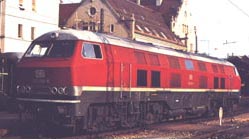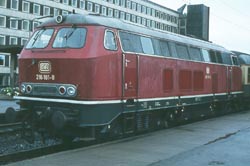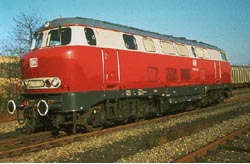| |
V 160
V 160
Construction
In service
V 160
The diesel locomotive program of 1953 (see also epoch III) anticipated also in a one engine 1600 hp (1180 kW) strong diesel locomotive meant for the middle-distance trains on non electrified mainlines. In the long run the locomotive had to replace the steam engines of class BR 03, BR 23, BR 38.10 (pr P 8), BR 39 (pr P 10), BR 50, BR 57 (pr G 10) and BR 78 (pr T 18) which were in service on these lines. Because the risen prices of coal and fuel oil the use of diesel locomotives became more and more important in the fifties. This new diesel locomotive had to get a place between the V 100 and the V 200 diesel locomotives.
This new diesel locomotive was meant for services in passenger and cargo trains with maximum speeds of 120 km/h. The locomotive must have a steam heated installation to heat up passenger coaches, and must have a startpower of 24 ton, and a duration power of 16 ton. This was sufficient to pull a train of 1200 ton on a hilly line of 10 ‰. Because the stores of sand, water and diesel fuel were quiet heavy, they choosed for a hydraulic transmission as already used with succes in the V 200.
 | | Locomotive for test purposes, the V 320 001 from Henschel |
The first prototype of this new locomotive class V 160 was delivered on 6 August 1960 to the DB. This one was built by Krupp in Essen. Until 1962 the V 160 002 up to 009 were following. These first prototype locomotives were in contrast with the later locomotives more rounded and had characteristic fronts. Because these fronts, the locomotives got later the nick name "lollo". The prototype locomotives 001-006 were built by Krupp, and the locomotives 007-009 were built by Henschel in 1962/63. The V 160 010, built in 1963 by Henschel was the last prototype locomotive. This locomotive had as first locomotive the sharp-edged fronts of the later locomotives. These sharp edged fronts were derived from the six axled test locomotive V 320 001 which was also built by Henschel. These test locomotive was the property of Henschel and was built on their own account. Before Henschel built the V 160 010, Henschel proposed the DB to use the same fronts as the V 320. The DB consented to it and wanted the same time also that they provided the locomotive with strengthened coupled axles from the engine and a couple of other minor modifications, for example the changing of the window arrangement at both sides. Also a push-pull installation was installed. And so the V 160 010 got the definite "face" of the V 160 family.
Because the good experiences with the prototype locomotives, the delivery of the serie locomotives V 160 began in 1964. The first delivery lasted until 1968 and contained 214 locomotives with the numbers V 160 011-224 (from epoch IV 216 011-224). The locomotives were built by Krupp, Henschel, Klöckner-Humboldt-Deutz (KHD), Krauss-Maffei and Maschinenbau AG Kiel (MaK). The locomotives V 160 were all equiped with a steam heating installation for heating passenger coaches.
The V 160 locomotives replaced the steam engines BR 0310 from the Bw Hagen-Eckesey, the BR 29 from the Bw Jünkerath, the BR 03 from the Bw Braunschweig, the oil burned BR 44 from Bebra and the BR 38.10 and BR 78 from the Bw's München and Mühldorf.
From the mass produced locomotive there are a couple of different variants. In epoch III the V 160, V 162 and the V 164. In epoch IV the BR 215 and the BR 218. The whole locomotive "family" contains in epoch III the locomotives V 160/162/164 and in epoch IV and V the locomotives BR 210/215/216/217/218/753. Although all these locomotives belong to the same "family" and althought they are constructive almost the same, I have divided them here in different chapters. But it is still, as far as the looks concerned, the same locomotive.
To reduce the energy for the heating installation, the DB decided in 1964 to develop a locomotive with gas turbines. This was done on the basis of a V 160 locomotive. The prototype, the V 169 001, later 219 001 was equiped with a helicopter turbine from General Motors. In this way the locomotive got 660 kW more power to relieve the main engine. The locomotive was taken out of service in 1978, but the gained experiences were used in the development of the BR 210. A BR 218 locomotive with also a gas turbine.
Construction
 | | Photo: Christian Splittgerber |
The chassis formed together with the superstructure a carrying construction. The chassis was made of steel which was welded. The locomotives were 16 meter long, the other variants like the V 162 and the V 164 are all 16,40 meter long. The locomotives V 160 were painted in dark red. The side skirts and the roofs were dark grey, like the side band along the ventilator grills.
The engine and the transmission were hanging elastically in a frame. The bogie frames were also welded. In the center of the bogie frames were the attach points for the lateral springs. Through four helical springs the chassis rested on the bogies. The axle load of the prototype locomotives was 18 ton on each axle, in total 72 ton. The axle load of the serie locomotives was 20 ton, in total 80 ton. Because these loads were the maximum which was allowed on mainlines the locomotives were mostly welded and they had used light metals to reduce the weight as much as they could.
The engine was located between the two sound isolated cabins, which were reachable by a sideway. The prototype locomotives V 160 001-010 were equiped with a 16-cylinder Maybach engine of type MD 870 1B (now this engine is of type MD 16 V 538 TB) with a power of 1397 kW at 1500 rpm. The serie locomotives were equiped with a engine of type MB 839 (now this engine is of type MB 16 V 652 TB) with 16 cylinders and a power of 1397 kW.
Locomotive V 160 082 was by means of a test provided with a new MAN diesel engine V6 V23/23 TL, a 12 cylinder 4 stroke engine with direct fuel injection and turbo. This engine had a power of 2200 kW, but despite this hugh power, the engine was regulated at 1470 kW because the transmission was not capable to handle this hugh power of 2200 kW. Later they installed a better and improved version of this engine in the locomotives of type BR 218. The power of the diesel locomotives depend mostly not on the used engine, but more on the hydraulic transmission and which sort of coupled axles are used.
Like the V 100 they choosed to install the engine in the center of the locomotive, so it could drive the four axles. The locomotives were provided with two gears, one for slow speeds up to 80 km/h and one gear for high speeds up to 120 km/h. The transmission used in the prototype locomotives was of type Voith L 218 rs and in the series locomotives of type L 821 rs.
The heating installation was installed between the transmission and cabin 2. The installation exists of a central heating boiler and a water reservoir. The boiler of type OK 4616 was originated from Vapor Heating and was built in license by Hagenuk. It was heated with fuel oil. The boiler could deliver 900 kg steam in one hour, which was sufficient to heat up 10 passenger coaches with an outside temperature of -20 °C. Besides this, the installation was also used to keep the coolant of the diesel engine on temperature so the hydraulic transmission didn't cool down. To relieve the extra battery of the locomotive, which provided the heating installation of energy, they installed an air cooled diesel generator, which drove another generator which provided the energy for the heating installation. These generator was also used to heat up passenger coaches.
The locomotives were equiped with high air pressure brakes of type Knorr, and a handbrake on each cabin. The required air for the brakes was generated by a MWM air compressor AKD 2 K 412 and by an electric driven airpump VV 160/200. These installations were also connected on the extra diesel generator in the locomotive.
A lightmachine was feeding the electric boardnet with a tension of 110 volt.
The supplies of diesel fuel, fuel oil and water were hold in the center of the locomotive. The supplies were hung under the chassis. Here was also the battery placed. The bigest part of the electric equipment for controling the engine and transmission was placed in closed boxes to the walls of the cabins.
The locomtives V 160 001-009, 026-035, 083-104, 130-169 and 185-199 got a push-pull installation and a installation to ride with more locomotives together.
In service
 | | Prototype locomotive V 160 003 "lollo" | Photo: DB Museum |
On 6 August 1960 the first locomotive V 160 001 was delivered by the Bundesbahn-Zentralamt in München. The locomotive was subject to extensive tests, and the gained experiences were all positive. Because of that, the other 8 locomotives built by Krupp (002-006) and Henschel (007-009) were unchanged.
After the test runs, the locomotives went into service from the Bw Hamburg-Altona, and later from the Bw Lübeck in the BD (Bundesbahn Direktion) Hamburg in the city express trains between Hamburg and Lübeck. The locomotives were used in push-pull trains with double stock coaches. But the locomotives were also used in cargo trains. In the passenger services on the relation Hamburg-Lübeck they replaced the steam engines BR 38.10 and BR 78.
An interesting detail here is that the prototype locomotives were long time used in the center of the push-pull trains. This made dividing and joining of trains a lot easier. The first locomotive which was moved to another Bw was the V 106 010, it went to the Bw Oldenburg Hbf due to returning defects on the push-pull installation.
The serie locomotives had their services in passenger and cargo trains on all non electrified lines of the DB, mainly in the western and northern part of Germany.
| Type no: |
V 160 001-009 |
V 160 010-224 |
| In service: |
1960 |
1964 |
| Manufacturer: |
Krupp, Henschel |
Krupp, Henschel, KM, KHD, MaK |
| Axle layout: |
B'B' |
B'B' |
| Gauge: |
143,5 cm |
143,5 cm |
| Length: |
16 m |
16 m |
| Weight: |
74 t (with 2/3 of supply) |
76,7 t (with 2/3 of supply) |
| Capacity diesel tank: |
3000 liter |
2700 liter |
| Traction: |
Diesel-hydraulisch
Dieselmotor:
Aantal: 1
Fabrikant: Maybach (MTU)
Vermogen: 1397 kW
(bij 1500 tpm) |
Diesel-hydraulisch
Dieselmotor:
Aantal: 1
Fabrikant: Maybach (MTU)
Vermogen: 1397 kW
(bij 1500 tpm) |
| Torque: |
235,2 kN |
235,2 kN |
| Train heating installation: |
steam |
steam |
| Top speed: |
80/120 km/h |
80/120 km/h |
|
